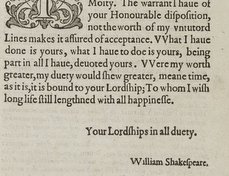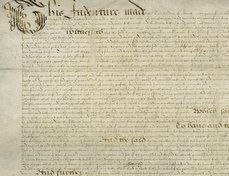Reproduced by permission of Shakespeare Birthplace Trust
Terms of use
The Shakespeare Birthplace Trust has graciously contributed images under a Creative Commons Attribution NonCommerical ShareAlike 4.0 International license. Visitors may download, link to and cite the images for personal research only. Any further use, including, but not limited to, unauthorized downloading or distribution of the images, commercial or third party use, is strictly prohibited. Visitors must contact the Shakespeare Birthplace Trust to request additional use, at: images.scla@shakespeare.org.uk
Document-specific information
Date: June 2, 1647
Repository: The Shakespeare Birthplace Trust, Stratford-upon-Avon, UK
Call number and opening: TR46/1/9
Robert Bearman, "Susanna Hall and her daughter Elizabeth Nash settle the estates inherited from William Shakespeare: the deed of settlement," Shakespeare Documented, https://doi.org/10.37078/447.
Shakespeare Birthplace Trust, TR46/1/9. See Shakespeare Documented, https://doi.org/10.37078/447.
Thomas Nash, first husband of Elizabeth Hall, Shakespeare’s granddaughter, died on April 4, 1647 without issue. Under his will, he left New Place, the four and a half yardlands in Old Stratford, and the Blackfriars Gatehouse directly to his kinsman, Edward Nash, with no regard to the interests of his mother-in-law and wife, still only thirty-nine, as provided for under the settlement of the Shakespeare family estate dated May 27, 1639. Within a week or two of Nash’s death, Susanna and Elizabeth therefore set in motion proceedings to secure a new settlement.
After arranging for the estates to pass by final concord to two trustees, a deed of settlement was drawn up, dated June 2, 1647 as shown here, in favor of Susanna Hall and Elizabeth Nash. This stipulated that two further trustees, William Hathaway of Weston-on-Avon, yeoman, and Thomas Hathaway of Stratford, joiner, would “recover” the premises from the trustees of the existing settlement and then arrange for it to be held by these new trustees for the use of Susanna Hall for life, with reversion to Elizabeth Nash for life and then her heirs. The properties are described much as they were in 1639, namely a messuage (a dwelling house) in Blackfriars in London near the Wardrobe, the “capital”, or chief, messuage in Stratford-upon-Avon called New Place, a messuage with appurtenances in Henley Street, Stratford-upon-Avon called the Maidenhead (named as such for the first time) in the tenure of John Rutter (i.e. Jane Hiccocks’s successor), an adjoining messuage in the occupation of Thomas Hart (Susanna’s cousin) and four and a half yard lands in the common fields of Stratford-upon-Avon, Old Stratford, Bishopton and Welcombe.
Four seals are attached, with two of the tags signed by the existing trustees (Richard Lane and William Smith), and the other two by Susanna Hall and her daughter Elizabeth Nash. Susanna used a small signet seal depicting a bird of some sort but Elizabeth’s (probably borrowed) bears six escallops. The other parties involved in the recovery, William and Thomas Hathaway, may have been related to Susanna Hall’s mother, Ann Hathaway, but this has not been established.
One further process was involved but Edward Nash eventually disputed the entire maneuver and filed a bill in Chancery in February 1648 seeking to compel Susanna and Elizabeth to implement the provisions of Thomas Nash’s will. Proceedings petered out towards the end of 1650, that is, after Susanna’s death, with no formal decree issued to settle the dispute. Some compromise may have been agreed, reflected in a provision of Elizabeth Nash’s will (by then Lady Barnard) whereby Edward Nash was given the opportunity to acquire New Place and the four and half yardlands “according to my promise formerly made to him."
Written by Robert Bearman
Last updated January 27, 2020
















